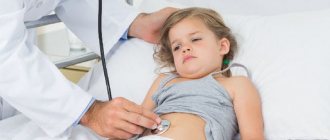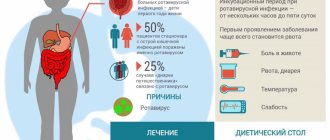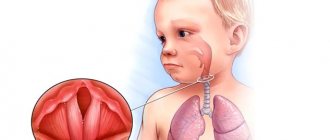Infectious disease specialist
Sinitsyn
Olga Valentinovna
34 years of experience
Highest qualification category of infectious disease doctor
Make an appointment
Rotavirus infection is a disease of viral origin that has an oral-fecal transmission mechanism. The peculiarity of the pathology is a combination of symptoms of damage to the digestive system with respiratory signs at the acute stage of the disease. The disease can be diagnosed in patients of any age, but more often in children under 2 years of age, in whom rotavirus accounts for up to 50% of all reported cases of intestinal infections.
Causes
The causative agent of rotavirus infection in children and adults is rotavirus, which has the ability to survive even when treated with potent disinfectant solutions. In the feces of a sick person, its vital activity persists for 7 months, in environmental conditions - for more than a month. The infection is transmitted from a carrier or a sick person through the fecal-oral route through water, food and household items, especially when the sanitary and hygienic condition of the premises is unsatisfactory.
Patients at risk for rotavirus include:
- childhood;
- with disturbances in the functioning of the immune system, when it is suppressed;
- with chronic intestinal diseases;
- with violations in the diet, as well as when changing baby food;
- working or visiting large groups;
- not observing the rules of personal hygiene.
What can parents do before the doctor arrives?
Even before the doctor arrives, parents should start giving their sick child something to drink. You can try to do this in various ways. Some children drink well during illness using a spoon. Someone will have to slowly pour liquid into their mouth from a syringe. The main thing is not to rush and do it evenly and regularly - 5-20 ml every few minutes. If the baby continues to have nausea or vomiting, you need to make the intervals between drinks a little longer, but do not stop offering the patient something to drink. In addition to saline solutions, it is useful to drink dried fruit compote and chamomile decoction.
To reduce the symptoms of the disease, sorbents and preparations containing probiotics are used. Sorbents ensure binding and removal of the pathogen from the body. For this purpose, carbon, fibrous, mineral or synthetic sorbents can be used, which effectively sorb and remove from the body food decomposition products formed during enzymatic deficiency, help accelerate epithelial regeneration, reduce flatulence and pain, and also do not affect the composition of normal intestinal flora .
In some situations, enzymes may be used in treatment if the child has difficulty digesting food due to severe damage to the intestines and pancreas.
In addition to medications, it is important to pay attention to diet during illness. To prevent nausea, food should be given to the child in small quantities and more often. For about a month, you should exclude dairy products, fresh vegetables, fruits, pasta, baked goods, pastries, sweets, and fried foods from your diet.
Food is served to the patient boiled, stewed or baked without crust. The child should have such food for about a month, and then the diet can be gradually expanded.
If you rush and do not follow a diet, recovery will slow down. Complications may arise and chronic diseases of the liver, stomach, intestines or pancreas may develop.
Symptoms
The disease has a cyclical development: the incubation period lasts up to 5 days, the acute period lasts 7 days, recovery occurs after another 3-5 days. The main signs of rotavirus infection include:
- sudden onset of symptoms of poisoning simultaneously with symptoms of intestinal infection;
- profuse vomiting and nausea that disappear within 24 hours from the onset of the disease;
- diarrhea with pain in the middle and upper abdomen, with the release of watery and foamy stool of a yellow-green hue;
- rumbling and transfusion in the abdomen;
- signs of general intoxication - headache, fever, feeling of weakness;
- characteristic respiratory symptoms - runny nose, swelling and redness of the throat;
- signs of dehydration caused by diarrhea and excessive vomiting.
Are you experiencing symptoms of rotavirus infection?
Only a doctor can accurately diagnose the disease. Don't delay your consultation - call
Prevention of rotavirus infection
In order to prevent the occurrence of the disease, it is necessary to follow simple and familiar everyday rules - wash your hands before eating, when returning home from a walk, after communicating with a sick person. These same rules must be taught to every child from a very young age. If someone in the family is sick with rotavirus infection or another infectious disease, then the patient should have separate dishes, towels, bed linen and household items, which should be soaked daily in disinfectant solutions and thoroughly washed with hot water or boiled.
The most effective way to prevent any infectious disease, including rotavirus infection, is vaccination, which can be given to children aged 1.5 to 8 months. Vaccination takes place in three stages with an interval of at least four weeks between each vaccination. It involves dropping vaccine drops into the baby's mouth. The main thing is that the child is healthy at this moment. Then, after proper vaccination, your baby will be protected from a very unpleasant rotavirus infection.
Even after suffering a rotavirus infection, there is a chance to get this disease again, since the body does not always develop lasting immunity to the disease. Therefore, it is important for parents to always follow hygiene rules and not forget to vaccinate their child.
Diagnostics
The results of the following studies help a pediatrician or therapist make an accurate diagnosis:
- a blood test showing an increase in the level of leukocytes;
- stool analysis, where there is an increase in leukocytes, starch grains, as well as undigested muscle fibers;
- serological blood test;
- positive results of infection of cell cultures with viral particles of the patient’s stool;
- PCR method that examines blood and stool samples.
Differential diagnosis is carried out to exclude a bacterial infection; the viral nature of the disease is confirmed by positive results of serological examination and bacterial culture.
Ways to combat high fever that occurs during illness
Rotavirus under a microscope
It is customary to lower the temperature only when the thermometer shows numbers above 38º. If the indicators are lower, then the temperature is brought down when it is difficult to bear, the patient complains of feeling unwell, and experiences discomfort. If the temperature rises above 38º, you need to put in Cefekon suppositories. They are relevant for children under 3 years of age.
But for older children, paracetamol is needed. The convenience of suppositories lies in the possibility of administering the drug to a sleeping child. When the temperature cannot be brought down in the usual way, you can combine paracetamol with a quarter of an analgin tablet. If a child is given medications containing paracetamol, take at least two hours between doses.
Excellently reduces the high temperature of rubbing. To do this, you can mix vodka and warm water or water with vinegar. Wipe the entire body with a moistened napkin, trying not to make the temperature of individual areas different. After wiping, you should put socks on your feet. They begin wiping if taking the tablets does not reduce the temperature after 30 minutes. It is necessary to ensure that a baby with a high temperature does not overheat. For this purpose, they do not put warm clothes on him or cover him with a warm blanket. Everything should be as usual.
If other compositions are used, the interval between doses is increased to 4 hours or longer, depending on the instructions.
If symptoms indicating an intestinal disorder appear, Enterofuril is introduced into the course of treatment. The dosage is prescribed according to the patient's age. Take it twice a day. Drink it for 5 days or more. This remedy will prevent prolonged diarrhea. Enterol successfully replaces Enterofuril.
Painkillers are started only when the diagnosis is confirmed. If it is definitely established that it is a rotavirus infection, you can give no-shpa. It is better to take the solution in an ampoule. Its contents are poured into the baby’s mouth, and can be washed down with water or tea.
As soon as the appetite appears, the baby should be given bactisubtil. It restores intestinal microflora and fights diarrhea. It should be given twice a day. Open the capsule, dissolve the powder in water, and give it before meals. Duration – 5 days.
Treatment
Currently, specific treatment regimens for rotavirus infection have not been developed. With a mild course of the disease, the symptoms go away on their own. Patients are advised to diet and take medications to restore fermentation in the digestive system. Enterosorbents that mitigate the symptoms of diarrhea and vomiting can help cope with the symptoms of a viral infection. If the patient is dehydrated, rehydration therapy with the use or intravenous administration of saline solutions is indicated.
Signs in adults
Rotavirus often affects adults. But the disease is mild. People think that they have a normal digestive disorder, so they don’t pay much attention to it. In adults, nausea and vomiting are rare. Usually everything is limited to diarrhea, a slight increase in temperature and weakness. Sometimes the symptoms are smoothed out to such an extent that the person does not pay attention to them at all.
And at this time, it still remains very contagious and can infect not only others in public places, but also children at home. The insignificant manifestation of signs of this disease can be explained by a more resistant organism and a higher degree of adaptability of the gastrointestinal tract to irritants of this kind. Therefore, if one person in a team or in a house gets sick, everyone else will experience the same thing, but not everyone will experience it to the same degree.
Questions and answers
How is rotavirus infection transmitted?
The mechanism of transmission of the virus is fecal-oral, where the causative agent of the disease enters the environment along with the feces of the carrier or patient, and then on dirty hands into the body of a healthy person. Household items, food, dirty water - all this can become a source of infection.
What can you eat if you have rotavirus infection?
Recommendations for a patient with rotavirus infection include dietary table No. 46 with restrictions on the amount of carbohydrates and dairy dishes, as well as an increase in the amount of protein foods. This diet plan is aimed at restoring the body’s immune system and stabilizing the digestive system that has been hit by the virus.
How long does rotavirus infection last?
The duration of the disease depends on the state of health of the person and his immune system. It may take 10-15 days from the moment of infection to complete recovery, where the first 6-7 days are an acute period with a whole bunch of unpleasant symptoms. The incubation period lasts from several hours to five days, after which the infection immediately makes itself felt with a sharp deterioration in the patient’s condition.
Intestinal flu - causes, symptoms and treatment
Rotavirus infection is an infectious disease caused by rotaviruses. Rotavirus, the symptoms of which manifest themselves in moderately severe symptoms of enteritis or gastroenteritis, is often combined with respiratory and intestinal syndromes during the initial manifestation of the disease. People of any age are susceptible to rotavirus infection, however, the incidence is most often observed among children from six months to two years. GENERAL DESCRIPTION
Rotavirus infection is also defined as RI, rotavirus gastroenteritis, rotavirosis, stomach or intestinal flu. The virus is transmitted primarily through food, that is, through unwashed food, dirty hands, etc. Thus, infection is possible in a variety of ways and, again, through products with rotavirus (in particular, dairy products should be highlighted here, which are especially susceptible to infection due to the specifics of their production). It is noteworthy that rotaviruses can live even in the refrigerator for a long period of time; chlorination of water does not affect them. Contrary to the generally accepted opinion regarding the effect of holy water on viruses due to its altered structure, it should be emphasized that it does not in any way affect the activity of rotaviruses.
Considering that rotavirus also provokes inflammation in the respiratory tract, its spread occurs in a similar way to the traditional influenza virus, that is, by droplets (coughing, sneezing). The virus penetrates the mucous membrane of the gastrointestinal tract (GIT), with the small intestine being predominantly affected. When the gastrointestinal tract is affected, rotavirus infection causes a disease such as enteritis, which manifests itself in inflammation of the intestinal mucosa, respectively, after which symptoms characteristic of rotavirus infection occur. They are expressed, in particular, in disturbances in the digestion of food, which provokes the development of diarrhea with simultaneous dehydration.
ROTAVIRUS INFECTION: SYMPTOMS IN CHILDREN
The course of the disease in children is more severe than in adults. The patient becomes a spreader of the virus from its first manifestations, remaining infectious until their complete completion along with the disease itself. Recovery, as a rule, comes in five to seven days, and the body develops a fairly strong immunity to the virus, which allows us to assert that subsequent infection with rotavirus is practically impossible. The incubation period ranges from 1 to 5 days, with the acute period beginning in children from 3-7 days. The severe course of the acute period of the disease can provoke a subsequent intensification and duration of this period, in this case it can be over 7 days. It takes about 4-5 days to recover from an illness.
Rotavirus infection is characterized by an acute onset. Its main manifestations are vomiting and a sharp increase in temperature, and diarrhea is possible. Stool with rotavirus infection is quite characteristic. So, on the first day it is yellow, liquid, on the second and third - clay-like, gray-yellow in color. As a rule, among the sick there is a runny nose and redness of the throat, as well as pain that occurs when swallowing. The acute period is characterized by a lack of appetite, as well as a state of loss of strength. Most often, rotavirus infection in children is characterized by the following scenario. So, the child gets up in the morning with lethargy and moodiness, and in the morning nausea appears. Vomiting is possible (often with mucus), and it is relevant even if the stomach is empty. Appetite is significantly reduced, after eating, vomiting occurs with the release of pieces of undigested food, and it also occurs after drinking liquid in a volume of over 50 ml.
The temperature then rises, and by the evening it can exceed 39°C. It is noteworthy that the disease is characterized by a stable and high temperature, that is, it is very difficult to bring it down. The duration of the condition with a high temperature can be about 5 days. Additionally, symptoms of rotavirus infection manifest themselves in the form of loose stools with an unpleasant odor, as well as abdominal pain. In very young children who are not yet able to explain their painful sensations, crying with a characteristic rumbling in the tummy is a sign of the presence of pain. Babies become irritable and whiny, in addition, they also rapidly lose weight. The second day of illness (as well as subsequent days) is characterized by drowsiness. Correct treatment allows you to eliminate all manifestations of the infection in question within up to 7 days, after which complete recovery occurs. The only thing that may subsequently cause discomfort for some time is loose stools. As for the intensity of manifestations, as well as the severity and duration of symptoms that rotavirus infection brings with it, in general they are different. It is noteworthy that the symptoms characteristic of infection are similar to the symptoms of other diseases of a more severe nature. These include, for example, salmonellosis or cholera. It is for this reason that if a child’s temperature rises, as well as nausea and/or loose stools, a doctor should be immediately called to the home. If you experience severe abdominal pain as an additional symptom, you should call an ambulance. Self-medication should be excluded until specific doctor's instructions.
COMPLICATIONS OF ROTAVIRUS INFECTION IN CHILDREN Proper treatment of rotavirus infection does not cause complications. However, if you exclude frequent drinking during diarrhea and vomiting, especially for children under one year of age, dehydration can even lead to death (up to 3% of all cases). Failure to take the required measures can also lead to the addition of an intestinal bacterial infection to the virus, which will further complicate the course of the disease and the child’s condition. It is imperative to monitor the child’s temperature, because if it rises for a long time within 39°C, the load on the cardiovascular system increases significantly, and convulsions are possible. In general, the disease does not carry with it any long-term consequences, so one can indicate favorable prognoses for the future.
SYMPTOMS OF ROTAVIRUS INFECTION IN ADULTS
As we have already noted, the course of the disease in adults is milder than in children.
As for recurrent incidence, here, in contrast, with a low level of antibodies, immunity is not developed properly against rotavirus infection, and therefore its symptoms may recur again. The specificity of the disease is the same. So, it is also a viral gastroenteritis, the course of which affects the gastrointestinal tract, and is also expressed in dehydration and general intoxication. The most common method of infection is contact with contaminated food, but household, water and other contact cannot be ruled out. In adults, intoxication is moderate, with lethargy, muscle weakness, headache and weakness, low-grade fever (up to 37.7°C). The pharynx becomes swollen, a white coating appears on the tongue, and the heart sounds are muffled (as determined by examination by a doctor). The onset of the disease is also characterized by its own severity, which manifests itself during the first day from the moment of infection. Pain in the abdomen (epigastric region) also occurs. The stool is watery (within 3-9 times per day), nausea and vomiting are also present among the symptoms. With this infection, diarrhea is profuse, characterized by a sharp odor and pale color, in some cases there may be an admixture of mucus, lasting up to a week. Given the severity of fluid loss, dehydration also develops quickly, which, in turn, can lead to circulatory failure and the body stopping the production of urine (anuria). It should be noted that rotavirus infection is often a current phenomenon that occurs as a complication of diseases affecting the respiratory tract (rhinitis, pharyngitis). Meanwhile, in many cases, the disease is characterized by a mild course with the absence of its characteristic symptoms in the form of nausea and vomiting, while stools are loose and infrequent. In any of the variants of the course of the disease, the patient is a carrier of the infection, and accordingly, in this he is dangerous for the people around him. ROTAVIRUS INFECTION: TREATMENT IN CHILDREN
There are no drugs as such to eliminate rotavirus. For this reason, treatment of infection is symptomatic, and, therefore, is aimed at normalizing the condition by restoring the water-salt balance, which is disrupted due to vomiting and diarrhea. Also, the goal of treatment is to combat the results obtained from infectious exposure in the form of dehydration, toxicosis and disturbances in the functioning of the urinary and cardiovascular systems. The manifestation of symptoms indicating gastrointestinal disorders in a child should in no case allow the consumption of milk and dairy products in any form, because they currently represent an excellent aid for the growth of bacteria. The child may also have a decreased appetite or it may be completely absent - in any case, there is no need to force him to eat. A good alternative to food in this state would be a small amount of jelly (water, jam and starch, that is, homemade), you can also give chicken broth. If the child does not refuse food, you can give him liquid rice porridge without oil (slightly sweetened). The main thing in nutrition is the insignificance of portion sizes, which will prevent the gag reflex with gradual saturation.
The main treatment, in addition to dietary restrictions, is the use of rehydration therapy; sorbents (activated carbon, attapulgite, dioctahedral smectite) are also applicable. Days on which severe vomiting or diarrhea occurs require replenishment of salts and fluid volumes lost through vomit and loose stools. This provides for the possibility of using rehydron (a sachet per liter of water) 50 ml at intervals of every half hour or hour until the liquid runs out. If you miss taking this solution because of sleep, you should not wake up the child, just as you should not give him a solution in a volume exceeding 50 ml for this reason, because he may simply vomit it. As for temperature, an important point is the fact that the virus dies at 38°C, therefore, there is no need to lower the temperature below this limit. This applies not only to rotavirus infection, but also to, say, a common cold - the well-known fact is that lowering the temperature before reaching this point is highly not recommended (figuratively speaking, the body and its immune system in particular need to be allowed to “fight”). To bring down a higher temperature, the doctor will prescribe suppositories for children under 3 years of age (ceficon); for older children, paracetamol is prescribed (in accordance with the dosage for a specific age). To bring down the temperature, you can also use rubdowns using a weak vodka solution (the whole body is wiped without allowing temperature changes in the areas between its individual sections). Rubbing is performed half an hour after taking medication for fever if there is no result. Gastrointestinal disorders with fever are eliminated by taking Enterofuril as prescribed by the doctor in the dosage indicated by him. The drug is intended for the treatment and prevention of infection, as well as to prevent prolonged diarrhea in a patient. Abdominal pain is eliminated with no-shpa, again, as prescribed by the doctor and in the dosage specified by him (usually in the form of a solution).
ROTAVIRUS INFECTION: TREATMENT IN ADULTS
Considering the greater adaptability of the adult organism to this type of shock (and the adaptability of the gastrointestinal tract to them in particular), as well as their stronger immunity, the disease occurs in a mild form of exposure. Considering this, special treatment is not required in this case. If the symptoms are severe, then treatment is aimed at eliminating specific symptoms. So, this may include preventing dehydration by frequently drinking saline solutions (based on rehydron), as well as water and tea.
Additionally, sorbents are taken to accelerate the removal of toxins and improve well-being, as well as astringent medications. An important point is also the dietary restriction (in particular, the restriction applies to the consumption of foods rich in carbohydrates in the form of fruits, sugar, vegetables), again, dairy products are excluded. Due to the fact that the disease is contagious, the patient must be isolated during treatment, thereby limiting the spread of rotavirus infection. Hospitalization is possible based on epidemiological and clinical indications. If you suspect a rotavirus infection, you should contact your primary care physician (pediatrician) or infectious disease specialist, who will determine the necessary treatment based on the tests required. Additionally, he can refer the patient to a gastroenterologist.
Interested?For detailed information, contact us in a way convenient for you: This block can be edited or deleted . | Place an order Ask a question |
When to see a doctor?
So, you have noticed your child has a runny nose, cough and loose stools. What to do? Perhaps there is no need to tempt fate by believing that this is just a mild intestinal upset due to the fact that the baby ate a little more fruit the day before or had a slight cold.
Therefore, if the child’s condition allows, go to see a doctor. Whereas if your baby has a high body temperature, frequent diarrhea and vomiting, call an ambulance immediately.
Symptoms of the disease
Manifestations of enteritis depend on the form of the disease and the cause that caused it. Doctors divide clinical manifestations into intestinal and extraintestinal. The latter include general weakness, loss of appetite, weight loss, dry skin, brittle hair, grayish color of the skin, thinning nails.
Intestinal symptoms:
- increased gas formation;
- rumbling in the stomach;
- diarrhea followed by constipation;
- aching pain in the right iliac region;
- unpleasant taste in the mouth.
Rotavirus and other intestinal infections: how to distinguish?
Children are often susceptible to infection with salmonella and dysentery bacillus.
For dysentery
The disease begins acutely with an increase in body temperature. Then liquid, mushy stool appears. Its frequency is about 10 times a day, but may be more often depending on the severity of the disease.
However, soon its volume decreases, it becomes scanty, a large amount of mucus appears in it, followed by streaks of blood. It is noteworthy that during the act of defecation (passing stool), nagging pain (tenesmus) occurs in the rectal area, sometimes quite pronounced.










